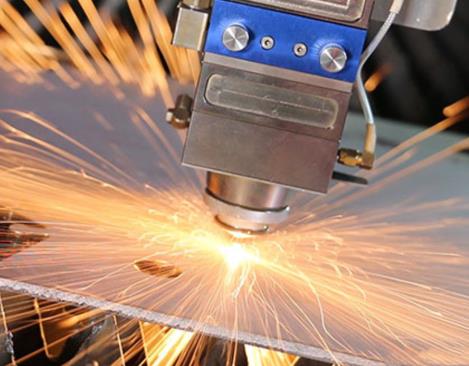Laser cutting, plasma cutting, and waterjet cutting are three mainstream cutting technologies. Their working principles are completely different, which gives each its unique advantages and applications.
Below, Rapid Model will explain the differences between these cutting methods in terms of their principles, pros and cons, and typical applications, summarized in a clear table.
1. Core Principle Comparison
| Feature | Laser Cutting | Plasma Cutting | Waterjet Cutting |
|---|---|---|---|
| Working Principle | Focused high-power laser beam melts, vaporizes, or burns the material, assisted by high-speed airflow to blow away molten material, achieving the cut. | Uses a high-temperature plasma arc to melt metal, with high-speed airflow blowing the molten metal away, forming the cut. | Uses ultra-high-pressure water (up to 600MPa) to create high-speed jets, mixed with abrasives, eroding the material for cutting. |
| Nature | Thermal cutting, high energy density | Thermal cutting, electric arc | Cold cutting, mechanical erosion |
| Energy Source | Photons (laser) | Electrical energy (plasma power) | Kinetic energy (high-pressure water) |
2. Pros, Cons, and Applications Comparison
| Comparison Factor | Laser Cutting | Plasma Cutting | Waterjet Cutting |
|---|---|---|---|
| Precision/Quality | ⭐⭐⭐⭐⭐ Very high. Narrow cuts (<0.1mm), smooth edges, minimal heat-affected zone, suitable for precision finishing. | ⭐⭐ Low. Wide cuts (1-2mm), rough edges, slag, and larger heat-affected zone, often requiring secondary processing. | ⭐⭐⭐⭐ Very high. Good cut quality with no heat-affected zone, but mild abrasive marks. |
| Cutting Speed | ⭐⭐⭐⭐⭐ Extremely fast for thin and medium plates. | ⭐⭐⭐⭐ Very fast for medium-thick plates, especially carbon steel. | ⭐ Slowest of the three. |
| Materials Cut | ⭐⭐⭐⭐ Wide range. Primarily metals (carbon steel, stainless steel, aluminum, copper, titanium, etc.) and some non-metals (acrylic, wood, plastics). High-reflective materials like pure copper and brass are difficult to cut. | ⭐ Narrow. Only conductive metals (carbon steel, stainless steel, aluminum, copper, etc.). | ⭐⭐⭐⭐⭐ Extremely versatile. Can cut almost any material: metals, stone, glass, ceramics, composites, rubber, plastics, food, etc. |
| Cutting Thickness | ⭐⭐⭐ Medium-thin plate specialist. Best for carbon steel <25mm, stainless steel <20mm. Efficiency decreases with thicker plates. | ⭐⭐⭐⭐⭐ Thick plate specialist. Excellent for medium-thick plates (>6mm), carbon steel up to 50mm+. Cost-effective. | ⭐⭐⭐⭐ Best for ultra-thick plates. No thickness limit, can easily cut materials up to 100mm or even 300mm+. |
| Operating Costs | High. Highest equipment investment, high power consumption, and wear on optical lenses and auxiliary gases. | Low. Lowest equipment and operational costs (power, consumables). | High. High initial investment, continuous consumables (high-pressure seals, nozzles, abrasives) costs. |
| Thermal Effect | Present, but minimal, generally not affecting most applications. | Significant. Changes material edge microstructure, causing hardening and stress. | None. Absolutely cold cutting, no changes to material properties. |
| Typical Applications | Precision parts, enclosures, kitchenware, automotive parts, signage, artwork, etc. | Heavy industry, steel structures, shipbuilding, machinery, and rough cutting. | Aerospace (composite materials, titanium alloys), stone art, glass decoration, building materials, food processing, and heat-sensitive or diverse materials. |
3. How to Choose the Right Cutting Method
There’s no absolute "best" cutting method, only the "most suitable" one. Here’s how to choose:
By Material:
- If cutting metal, choose between laser and plasma.
- For non-metal materials (stone, glass, plastic) or heat-sensitive composites, waterjet is the only or best choice.
By Thickness (for Metals):
- Thin (<6mm) to medium plates (<25mm): Choose laser cutting for precision and quality.
- Medium to thick plates (>6mm): Choose plasma cutting for speed and cost. If heat sensitivity is a concern, opt for waterjet.
By Requirements:
- For extreme precision and aesthetics: Choose laser cutting.
- For faster speed and lower cost with less precision: Choose plasma cutting.
- For heat-sensitive or diverse materials: Choose waterjet cutting.
In summary:
- Laser cutting is like a surgeon’s scalpel: precise, efficient, and suited for fine work.
- Plasma cutting is like a strongman’s axe: powerful, fast, and suited for heavy-duty tasks.
- Waterjet cutting is like a versatile tool: it can cut anything without leaving any heat-affected zone, but it’s slower and more expensive.
4. Cost Analysis for Cutting
The cost structures of laser, plasma, and waterjet cutting differ greatly, and there’s no absolute "cheapest" option. The cost depends entirely on your specific application—material type, thickness, and production volume. Below is a detailed breakdown of their cost structures:
Cost Breakdown Overview
| Cost Type | Laser Cutting | Plasma Cutting | Waterjet Cutting |
|---|---|---|---|
| Equipment Investment | Very high | Low to medium | Very high (high-pressure systems) |
| Direct Operating Costs | Power + Gas + Lenses/Nozzles | Power + Electrodes/Nozzles | Power + Abrasives + Nozzles/Seals |
| Indirect Costs | Complex maintenance, high technical requirements | Relatively simple maintenance | Complex maintenance, high-pressure system risks |
| Production Efficiency | Fast for thin plates, slower for thicker ones | Fast for medium-thick plates | Slow for all materials |
| Core Cost Drivers | Gas consumption, power | Power, consumables | Abrasive consumption, consumables |
Conclusion
The most accurate way to determine the best cutting method for your needs is to consult with Rapid Model. Bring your drawings (materials, thickness, and quantity), and we’ll calculate the most accurate price based on your specific part layout and process parameters.



